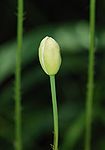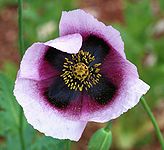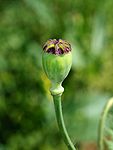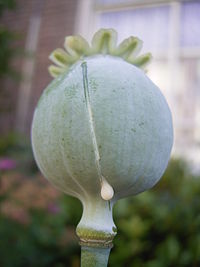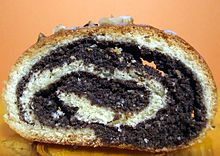- Opium poppy
-
Opium poppy 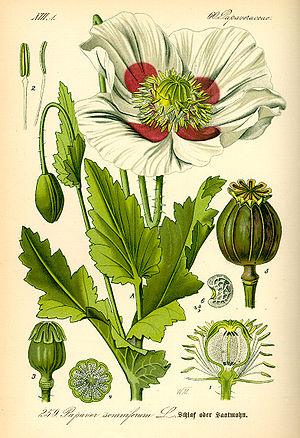
Papaver somniferum Scientific classification Kingdom: Plantae Division: Magnoliophyta Class: Magnoliopsida Order: Ranunculales Family: Papaveraceae Genus: Papaver Species: P. somniferum Binomial name Papaver somniferum
L.Opium poppy, Papaver somniferum, is the species of plant from which opium and poppy seeds are extracted. Opium is the source of many opiates, including morphine (and its derivative heroin), thebaine, codeine, papaverine, and noscapine. The Latin botanical name means the "sleep-bringing poppy", referring to the sedative properties of some of these opiates.
The poppy is the only species of Papaveraceae that is an agricultural crop grown on a large scale. Other species, Papaver rhoeas and Papaver argemone, are important agricultural weeds, and may be mistaken for the crop.
The plant itself is also valuable for ornamental purposes, and has been known as the "common garden poppy", referencing all the group of poppy plants.
Poppy seeds of Papaver somniferum are an important food item and the source of poppyseed oil, a healthful edible oil that has many uses. It is widely grown as an ornamental flower throughout Europe, North America, South America, and Asia.
Contents
Varieties
Papaver somniferum has many sub-species or varieties and cultivars. Colors of the flower vary widely, as do other physical characteristics such as number and shape of petals, number of flowers and fruits, number of seeds, color of seeds, production of opium, etc.
Papaver somniferum Paeoniflorum Group (sometimes called Papaver paeoniflorum) is a sub-type of opium poppy whose flowers are highly double, and are grown in many colors. Papaver somniferum Laciniatum Group (sometimes called Papaver laciniatum) is a sub-type of opium poppy whose flowers are highly double and deeply lobed, to the point of looking like a ruffly pompon.
A few of the varieties, notably the Norman and Przemko varieties, have low morphine content (less than one percent), much higher concentrations of other alkaloids. Most varieties, however, including those most popular for ornamental use or seed production, have a higher morphine content, with the average content being 10%.[1][2]
Opiates
The opium poppy is the principal source of most naturally occurring μ-opioid receptor agonist opioids. The opium poppy is, by definition, the root source of all opioids considered opiates. Opiates are extracted from opium and poppy straw. Opium (also called “raw opium”) is the latex harvested by making incisions on the green capsules (seed pods). Poppy straw is the dried mature plant except the seeds, harvested by mowing.
From opium and poppy straw alkaloids are extracted such as morphine, thebaine, codeine and oripavine. Morphine is the predominant alkaloid found in the varieties of opium poppy plant cultivated in most producing countries.[3]
History
Use of the opium poppy predates written history. Images of opium poppies have been found in ancient Sumerian artifacts (ca. 4000 BC). The opium poppy was also known to the ancient Greeks, from whom it gained its modern name of opium. Remains have been discovered at sites such as Kalapodi and Kastanas.[citation needed]
Opium was used for treating asthma, stomach illnesses, and bad eyesight. The First and Second Opium Wars between China, the British Empire and France took place in the late 1830s through the early 1860s when the Chinese attempted to stop western traders selling opium into China.
Many modern writers, particularly in the nineteenth century, have written on the opium poppy and its effects, notably L. Frank Baum in The Wonderful Wizard of Oz and Thomas de Quincey in Confessions of an English Opium Eater
The French Romantic composer Hector Berlioz used opium to be inspired, subsequently producing his Symphonie Fantastique. In this work, a young artist overdoses on opium and experiences a series of visions of his unrequited love.
Opium poppies (flower and fruit) appear on the coat of arms of the Royal College of Anaesthetists.
Legality
Opium poppy cultivation in the United Kingdom does not require a licence, but extracting opium for medicinal products does.[4]
In Italy it is forbidden to grow Papaver somniferum to extract the alkaloids, but small numbers of specimens can be grown without special permits for purely ornamental purposes. In the United States, opium is listed as a Schedule II controlled substance by the Drug Enforcement Administration. In addition, "Opium poppy and poppy straw" are also prohibited.[5] However, this is not typically enforced for poppies grown or sold for ornamental or food purposes.[1]The seeds themselves contain very small amounts of opiates.[1] However, the television show MythBusters demonstrated that one could test positive for narcotics after consuming four poppy seed bagels. On the show Brainiac: Science Abuse, subjects tested positive after eating only two poppy seed bagels.
In the United Arab Emirates, where the drug law is especially stern, at least one man was reported to have been imprisoned for possessing poppy seeds obtained from a bread roll.[6]
In northern Burma opium bans have ended a century old tradition of growing poppy. Between 20,000 and 30,000 ex-poppyfarmers left the Kokang region as a result of the ban in 2002. [7] People from the Wa region, where the ban was implemented in 2005, fled to areas where growing opium is still possible.
Poppies as medicine
Capsule of Papaver somniferum showing latex (opium) exuding from incision
Australia, Turkey and India are the major producers of poppy for medicinal purposes and poppy-based drugs, such as morphine or codeine.[8] The USA has a policy of sourcing 80% of its narcotic raw materials from the traditional producers, India and Turkey.[9]
A recent initiative to extend opium production for medicinal purposes called Poppy for Medicine was launched by The Senlis Council which proposes that Afghanistan could produce medicinal opium under a scheme similar to that operating in Turkey and India.[10] The Council proposes licensing poppy production in Afghanistan, within an integrated control system supported by the Afghan government and its international allies, to promote economic growth in the country, create vital drugs and combat poverty and the diversion of illegal opium to drug traffickers and terrorist elements. Interestingly, Senlis is on record advocating reintroduction of poppy into areas of Afghanistan, specifically Kunduz, which has been poppy free for some time.
The Senlis proposal is based in part on the assertion that there is an acute global shortage of opium poppy-based medicines some of which (morphine) are on the World Health Organisation's list of essential drugs as they are the most effective way of relieving severe pain. This assertion is contradicted by the International Narcotics Control Board (INCB), the "independent and quasi-judicial control organ monitoring the implementation of the United Nations drug control conventions". INCB reports that the supply of opiates is greatly in excess of demand.[11]
The British government has given the go-ahead to the pharmaceutical company Macfarlan Smith (a Johnson Matthey company) to cultivate opium poppies in England for medicinal reasons. This move is well-received by British farmers, with a major opium poppy field based in Didcot, England.[12]
In March 2010, researchers from the Department of Biological Sciences at the University of Calgary published an article in Nature Chemical Biology about their discovery of two enzymes and their encoding genes, thebaine 6-O-demethylase (T6ODM) and codeine O-demethylase (CODM), involved in morphine biosynthesis derived from the opium poppy.[13] The enzymes were identified as non-heme dioxygenases, and were isolated using functional genomics.[13] Codeine O-demethylase produces the enzyme that converts codeine into morphine.[14]
Use as food
The opium poppy is the source of two food ingredients: poppy seed and poppyseed oil. The seeds contain very low levels of opiates,[1] and the oil extracted from them contains even less. Both the oil and the seed residue also have commercial uses.
Poppy seeds
Main article: Poppy seedPoppy seeds are commonly used in cuisine from many different cultures. Poppy seeds can be dry roasted and ground to be used in wet curry (curry paste) or dry curry. They have a creamy and nut like flavor, and when used with ground coconut, the seeds provide a unique and flavour-rich curry base. [1]
Ornamental cultivation
Once known as the "common garden poppy", live plants and seeds of the opium poppy are widely sold by seed companies and nurseries in most of the western world, including the United States. Poppies are sought after by gardeners for the vivid coloration of the blooms, the hardiness and reliability of the poppy plants, the exotic chocolate-vegetal fragrance note of some cultivars, and the ease of growing the plants from purchased flats of seedlings or by direct sowing of the seed. Poppy seed pods are also sold for dried flower arrangements.
It has been suggested that, since "opium poppy and poppy straw" are listed in Schedule II of the United States' Controlled Substances Act, a DEA license may be required to grow poppies in ornamental or display gardens. In fact the legal status of strictly ornamental poppy gardens is more nuanced, and destruction of ornamental poppy installations or prosecution of gardeners (except those caught extracting opium via capsule scarification or tea extraction) are virtually unheard of.[1] During the early spring, opium poppies can be seen flowering in gardens throughout North America and Europe, and beautiful displays are found in many private planters, as well as in public botanical and museum gardens (e.g. United States Botanical Garden, Missouri Botanical Garden, North Carolina Botanical Garden, residential garden, Seattle, WA, and residential garden, Hartford, CT).
Many countries grow the plants, and some rely heavily on the commercial production of the drug as a major source of income. As an additional source of profit, the seeds of the same plants are sold for use in foods, so that cultivation of the plant is a significant source of income. This international trade in seeds of Papaver somniferum was addressed by a UN resolution "to fight the international trade in illicit opium poppy seeds" on July 28, 1998.
Popular culture
Recently a feature film entitled, "Poppies: Odyssey of an Opium Eater" was produced (Never released) exploring the life of Eric Detzer and how he would go about acquiring opium poppies from flower shops and gardens in the Pacific Northwest (north of Seattle) to feed his addiction. This is a true story based on a book written by Detzer starring David Bertelsen. Since the festival release of this film in Breckenridge, CO, eBay has stopped allowing the sale of opium poppy pods on their auction site. This may also be attributed to the death of a Colorado teen who overdosed on opium tea around the same time.
What may be the most well known literary use of the poppy occurs both in L. Frank Baum's The Wonderful Wizard of Oz and in MGM's classic 1939 film based on the novel.
In the novel, while on their way to the Emerald City, Dorothy, the Scarecrow, the Tin Man, and the Cowardly Lion walk through a field of poppies, and both Dorothy and the Lion mysteriously fall asleep. The Scarecrow and the Tin Man, not being made of flesh and blood, are unaffected. They carry Dorothy to safety and place her on the ground beyond the poppy field. While they are considering how to help the Lion, a field mouse runs in front of them, fleeing a cougar. The Tin Man beheads the cougar with his axe, and the field mouse pledges her eternal gratitude. Being the Queen of the Field Mice, she gathers all her subjects together. The Tin Man cuts down several trees, and builds a wagon. The Lion is pushed onto it, and the mice pull the wagon safely out of the poppy field.
In the 1939 film, the sequence is considerably altered. The poppy field is conjured up by the Wicked Witch of the West, and it appears directly in front of the Emerald City, preventing the four travelers from reaching it. As in the novel, Dorothy and the Cowardly Lion fall asleep, but in a direct reversal of the book, the Scarecrow and the Tin Man are unable to carry Dorothy. Glinda, who has been watching over them, conjures up a snowfall which kills the poppies' narcotic power and enables Dorothy and the Lion to awaken. Unfortunately, the Tin Man has been weeping in despair, and the combination of his tears and the wet snow has caused him to rust. After he is oiled by Dorothy, the four skip happily toward the Emerald City.
In Baum's other Oz books, Oz's ruler, Princess Ozma, is often shown wearing poppies in her hair as decoration.
Poppy dilemma in Afghanistan
After the ousting of the Taliban from the town of Marja in the Southern Afghan province Helmand by Operation Moshtarak, American and NATO commanders were confronted with the dilemma of, on the one hand, the need to "win the hearts and minds" of the local population and, on the other, the need to eradicate poppy fields and destroy the opium economy that allegedly financed the Taliban insurgency. It has been speculated that US Marines were ordered to ignore preliminarily the crops to avoid trampling the local farmers' livelihood, and that this might have been because there were no significant poppy fields there before the first US forces arrived.[15][16]
Sources and notes
Inline citations
- ^ a b c d e "Poppy law" on Erowid.org
- ^ Ayatollah (2006-02-25). "How potent are the major culinary (spicerack) varieties such as McCormick?". Poppies. http://www.poppies.org/faq/introduction/how-potent-are-the-major-culinary-spicerack-varieties-such-as-mccormick/#more. Retrieved 2009-09-02.
- ^ "International Narcotics Control Bureau, Technical Reports, 2008, Part IV, Statistical information on narcotic drugs"
- ^ Phillip, Rhodri, & Barry Wigmore (2007-07-14). "The painkilling fields: England's opium poppies that tackle the NHS morphine crisis". Evening Standard. http://www.thisislondon.co.uk/news/article-23404311-details/The%20painkilling%20fields:%20England's%20opium%20poppies%20that%20tackle%20the%20NHS%20morphine%20crisis/article.do. Retrieved 2009-09-02.
- ^ Ayatollah. "Drug Scheduling". Drug Enforcement Administration. http://www.usdoj.gov/dea/pubs/scheduling.html. Retrieved 2009-09-02.
- ^ McGrath, Ginny (2008-02-08). "Travellers who 'smuggle' poppy seeds face Dubai jail". The Times. http://www.timesonline.co.uk/tol/travel/news/article3333905.ece. Retrieved 2009-09-02.
- ^ page 4 of the Drug Policy Briefing nr. 29 by the Transnational Institute
- ^ Dicker, Jason. "The Poppy Industry in Tasmania". University of Tasmania. http://www.launc.tased.edu.au/online/sciences/agsci/alkalo/popindus.htm. Retrieved 2009-09-02.
- ^ Braund, Claire (2001). "Research driving the Tasmanian poppy industry". Australian Society of Agronomy. http://www.regional.org.au/au/asa/2001/news.htm#P54_6133. Retrieved 2009-09-02.[dead link]
- ^ "Poppy for Medicine". Poppy for Medicine. http://www.poppyformedicine.net/. Retrieved 2009-09-02.
- ^ International Narcotics Control Board, 2004, Report 2004, Vienna: International Narcotics Control Board: 23.
- ^ "Review of undertakings by Macfarlan Smith Limited". Department for Business, Innovation and Skills. March 2006. http://www.berr.gov.uk/whatwedo/businesslaw/competition/market-studies/opium/page33834.html. Retrieved 2009-09-02.
- ^ a b Jillian M Hagel and Peter J Facchini (2010-03-14). "Dioxygenases catalyze the O-demethylation steps of morphine biosynthesis in opium poppy". Nature Chemical Biology (Nature Publishing Group) 6: 273. doi:10.1038/nchembio.317. PMID 20228795. http://www.nature.com/nchembio/journal/vaop/ncurrent/full/nchembio.317.html. Retrieved 2010-03-15.
- ^ "Genetic secrets of poppies' painkillers unlocked". The Canadian Press, Toronto Star. 2010-03-15. http://www.healthzone.ca/health/newsfeatures/research/article/779869--genetic-secrets-of-poppies-painkillers-unlocked. Retrieved 2010-03-15.
- ^ "U.S. Turns a Blind Eye to Opium in Afghan Town"
- ^ "Afghan drug cartels squeeze poppy farmers"
General references
- The Heroin Harvest
- Comprehensive profile for Papaver somniferum from MaltaWildPlants.com
- Opium FAQ v1.0 from Opioids.com
- Papaver Somniferum Facts from somniferum.com
- Opium Poppy Cultivation and Heroin Processing in Southeast Asia from the School of Pacific and Asian Studies
- "Downward Spiral - Banning Opium in Afghanistan and Burma", Transnational Institute TNI, Debate Paper, June 2005
- "Withdrawal Symptoms in the Golden Triangle - A Drugs Market in Disarray" TNI Paper by Tom Kramer et al.
- Chouvy P.A., 2009, "Opium. Uncovering the Politics of the Poppy", London, I.B. Tauris (Cambridge, Harvard University Press: 2010)
- Rätsch,Christian "The Encyclopedia of Psychoactive Plants, Enthnopharmacology and Its Applications" 1998/2005, Rochester, Vermont, Park Street Press, ISBN 9780892819782
Photos
Wikimedia Foundation. 2010.

